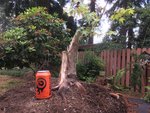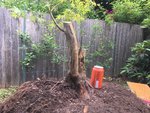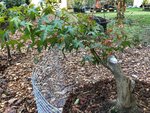G-Hoppa
Sapling
The site will be bulldozed in a week. Today is my only access. The tree has been damaged (backed into maybe?) and is broken/leaning to the ground, but still fully alive & leafed out & hardened off. The caliper is approx 4"-5", the root spread very nice - worth the effort to dig even though it's the wrong season and there's a good chance it'll die no matter what. Hey - it's free and it'll be ripped out in a week anyway.
What can I do to maximize my chances of keeping it alive?
It was planted a couple years ago, so it's not too long out of a big nursery pot. I'm hoping that means the roots will be somewhat contained in a smaller area.I was thinking I'd chop & seal at the bent/broken point about 8 inches above the nebari, get the biggest rootball I can wrangle into the truck, and get it into warm damp shade. This would remove all branches & leaves, but I'm hoping there's enough energy stored in the fat trunk/base to stay alive and maybe push a few new buds this summer.
Any other thoughts?
What can I do to maximize my chances of keeping it alive?
It was planted a couple years ago, so it's not too long out of a big nursery pot. I'm hoping that means the roots will be somewhat contained in a smaller area.I was thinking I'd chop & seal at the bent/broken point about 8 inches above the nebari, get the biggest rootball I can wrangle into the truck, and get it into warm damp shade. This would remove all branches & leaves, but I'm hoping there's enough energy stored in the fat trunk/base to stay alive and maybe push a few new buds this summer.
Any other thoughts?








